ZTE V8200PLUS WCDMA Digital Mobile Handset User Manual
ZTE Corporation WCDMA Digital Mobile Handset
ZTE >
User manual
V8200+
User Manual

-1-
Using your phone
Thanks for choosing the Vtelca V8200+, which will refer to as
‘phone’ from now on. Under the Android operating system, the
phone supports 3G high-speed Internet access, which brings you
brand new experiences.
Don’t worry if the pictures we use to demonstrate your phone’s
functions look a little different from what you see on the screen.
It’s the functions that matter.
For more information about how to use your phone, refer to the
User manual on the phone.
To read the user manual, do as follows:
1. Hold the Power key to turn on your phone.
2. Tap the icon to open the All Apps select Settings >
About phone > User manual.
You can also copy the user manual from your phone into your
computer,do as follows:
1. Connect your phone to your computer using the USB cable.
2. Tap the Menu key to select System Settings > About phone >
Share user manual.
3. Select User manual to copy the user manual into your
computer.
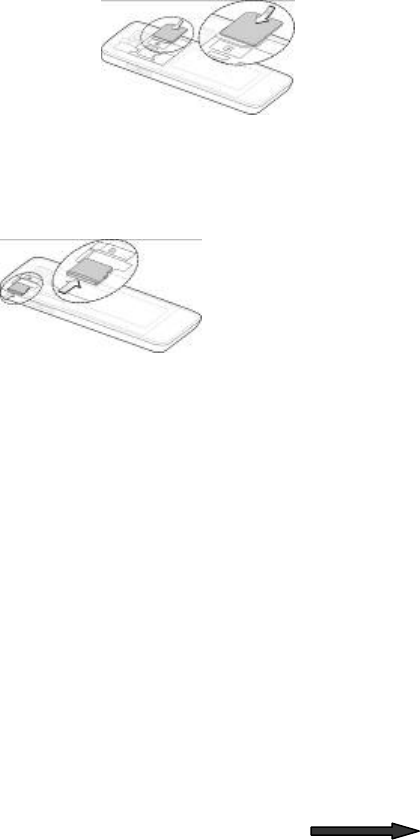
-2-
Before getting started
Inserting and removing the SIM
1. Switch off your phone and disconnect any external power.
2. Remove the back cover.
3. Hold your SIM on the cut
corner, and slide it face
down into the card holder.
4. Replace the back cover.
Inserting a memory card
1. Remove the back cover.
2. Push tightly until the card is installed in the correct position
and replace the back cover.

-3-
Using the battery
Charging the battery
The battery is not fully charged when you
unpack it for the first time. Please exhaust the
capacity of the battery before you recharge it for
the first time.To ensure the battery is always in
its best condition, please charge the battery 8
hours for the first time and recharge it later at
least 2 hours each time.
1. Connect the charger to the phone, and
insert the charger to the standard power
socket.
2. Please disconnect the charger from the power socket after
the charging is completed.
Tips:
To charge the battery, you can also connect the phone to the
PC through the USB cable.
During charging, the phone and charger may normally
become hot.
Dispose of battery properly
Please detach the battery in the following way to protect natural
resources if you are ready to throw away your mobile phone after
its lifespan expires.
-4-
1. Open the back cover of the mobile phone, and then use the
screwdriver to remove the six screws fixed on the battery
cover.
2. Cut off the connection wires and take out the battery.
Please separate batteries from other types of waste and recycle
them through your local, free battery return system.
Note: if you detach the battery during the warranty period, your
phone won't be warranted.
Power on/off
Powering on
Long press the Power key until the power-on animation appears.
Powering off
Long press the Power key to display the menu Phone options
and select Power off.
Mandatory restart
Long press the Power key till the phone vibrate, release the
power key, the phone will stop vibrating and restart.
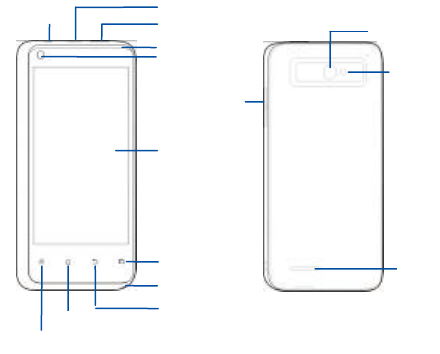
-5-
Recent apps
key
Touch
Back key
Home key
Menu key
Earpiec Came
r
a
Power key
Side keys
USB
t
Headset
Front
Speak
er
Microphon
Flash
Getting to know your phone

-6-
Descriptions of Keys
Keys Functions
Power key
Press it to turn on/off the display.
Long press it to open a menu with options
for Airplane mode, for Silent mode, for
Vibration mode and for powering off the
phone
Home key
Touch it to open the home screen. If you’re
viewing the left or right extended home
screen, Touch it to open the central home
screen.
Touch & hold the key to open the most
recently used applications screen.
Menu key Touch it to open a menu with items that
affect the current screen or application.
Back key
Touch it to open the previous screen you
were working in.
If the onscreen keyboard is open, Touch it
to close the keyboard.
Recent
apps key
Opens a list of thumbnail images of apps
you've worked with recently.
To open an app, touch it. To remove a
thumbnail from the list, swipe it left or right.
Volume keys
Adjust the volume. Long press the UP key to
adjust to the maximum volume, and long
press the DOWN key to adjust to the silence
mode.
-7-
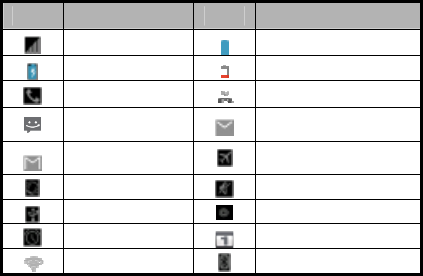
-8-
Onscreen icons
Icons Descriptions Icons Descriptions
Signal strength Full battery
Charging Low battery
In a call Missed calls
You have an unread
message. You have an unread E-mail.
You have an unread
G-mail. Airplane mode
Vibration mode Silent mode
Connected to a PC Music playing
Alarm clock on New calendar reminder
Wi-Fi function on Bluetooth function is on
-9-
Basic Operation
Screen control
You can control your phone through a series of operations on the
screen.
Touch: you can touch the items on the screen to select them,
to open the applications, or using the keyboard to input
characters.
Slide or slide: Quickly move your finger across the surface
of the screen, without pausing when you first touch (so you
don't drag something instead).
Touch & hold: you can touch & hold some items to get the
item’s available menu.
Drag: you can drag some items on the screen to realize
some operations.
Switch between landscape mode and portrait mode: you
can switch to the landscape mode by rotating your phone.
The landscape mode is only valid under some interfaces,
such as text input interface, message viewing interface, etc.
Pinch: In some apps (such as Maps, Browser, and Gallery),
you can zoom in and out by placing two fingers on the
screen at once and pinching them together (to zoom out) or
spreading them apart (to zoom in).
Wi-Fi
-10-
Turn on/off Wi-Fi
1. On the home screen, press the Menu key and then press
System settings.
2. Slide the Wi-Fi switch to the ON or OFF position.
Connect to Wi-Fi
1. On the home screen, press the Menu key and then press
System settings.
2. Slide the Wi-Fi switch to the ON position.
3. Touch Wi-Fi, then in the Wi-Fi settings screen, touch ADD
NETWORK.
4. Enter the Network SSID (name) of the network. If necessary,
enter security or other network configuration details.
5.Touch Save.
If you’ve selected an open network, your phone will automatically
connect to it.
Tethering & portable hotspot
You can share your phone’s mobile data connection via USB or
as a portable Wi-Fi hotsport.
Turn on/off portable Wi-Fi hotspot
1. On the home screen, press the Menu key, then press System
settings > More...
2. Press Tethering & portable hotspot, Check or uncheck
Portable Wi-Fi hotspot to turn it on or off.
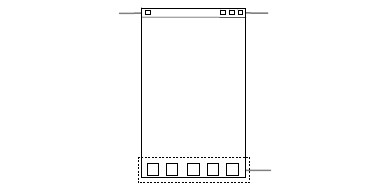
-11-
Note: As Portable Wi-Fi hotspot is enabled, Wi-Fi function shall
automatically close.
Portable Wi-Fi hotspot settings
1. On the home screen, press the Menu key, then press ystem
settings > More...
2. Press Tethering & portable hotspot, Check Portable Wi-Fi
hotspot to turn on hotspot.
3. Press Configure portable Wi-Fi hotspot to set the hotspot
name and password.
After the password for hotspot is set, this password needs to
be entered when other Wi-Fi devices connect to the phone
through Wi-Fi.
Home screen
Favorites tray
Barra de estado
Shows the signal
strength, battery
status, etc.
Barra de
notificaciones
Drag the
notification bar
down from the top
of the screen to
open
the

-12-
Arrange & work with apps
To see all your apps, touch the All Apps Icon on any Home
screen. After opening the All Apps, press an icon to enter the
corresponding application. Touch the Back key to return to the
previous screen. Touch the Home key to return to the home
screen.
From All Apps, you can:
Explore your widgets: Touch the widgets tab at the top of
any All Apps screen.
Get more apps.: Touch the Play Store icon.
Switch to a recently used application
Touch the Recent apps key. A window opens with icons of
applications that you’ve used recently. Touch an icon to open its
application.
Manage notifications
See your notifications: Swipe your finger down from the
top of the screen.
Respond to a notification: Touch it.
Dismiss a notification: Swipe it sideways.

-13-
Dismiss all notifications: Touch the X in the top right
corner.
Favorites tray
The app icons you keep in the favorites tray remain visible on
every Home screen.
Touch, hold, & slide to move one of the Favorites icons out of the
tray. Then use the same technique to move another one into the
same position.
The All Apps icon in the center is permanent, You can't move
it.
Use folders
You can combine several app icons in a folder. Drop one app
icon over another on a Home screen, and the two icons will be
combined.
From any Home screen, you can
- Open a folder: Touch it. The folder opens.
- Rename a folder: Touch its name.
- Move icons around your Home screens: Touch, hold, and
drag.
Quickly open and close data connection
Drag the notification bar down, touch the icon to open or
close the data connection to avoid the unnecessary network
costs.

-14-
Add icons to the home screen
Touch & hold the app icon, slide your finger, and lift your finger to
drop the icon in place.
Delete icons on the home screen
Touch & hold the app icon, slide your finger toward the top of the
screen, and drop the app over the Remove icon .
Change wallpaper
1. Touch & hold anywhere on the home screen that's not
occupied. A list of options appears.
2. Select wallpaper from Gallery/Live wallpapers/Wallpapers.
Switch to sleep mode
Sleep mode is a kind of power saving mode, which also helps to
prevent inadvertent operations. If your phone has been in idle
mode for a while, it will automatically switch to sleep mode.
You can also press the Power key to turn off the screen and
enable sleep mode.
Wake up your phone
After the phone switches to the sleep mode, the screen will be
turned off and locked. In this case, please awake your phone and
unlock the screen if you want to use your phone.

-15-
1. Press the Power key to turn on the screen.
2. Long touch to unlock the screen.
You can adjust your phone's lock settings:
1. From the Home screen, press the Menu key then select
Settings> Security> Screen lock.
2. Touch the type of lock you'd like to use.
Use the SD card as USB storage device
1. Insert the SD card into the card slot on the phone.
2. Connect the phone to the PC through the USB cable. The PC
will automatically recognize the SD card as removable storage
device.
3. Touch “Open USB storage device”.
Now you can exchange data between the PC and the SD card.
Text Input
Your phone supports the Android keyboard input method, the
Google voice typing input method and the TouchPal input
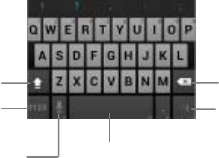
-16-
method. The Android keyboard and the TouchPal input method
support multiple language inputs.
On the home screen, touch the Menu key and then select
Settings > Language & input. Touch Default > Select input
method and select the input options.
During the text input, drag the notification bar down from the top
of the screen to select input method.
Android Keyboard
Google voice typing
Delete a character
before the cursor.
Insert a smiley.
Change to symbol/numbe
r
mode. Tap again to
change back.
Insert space
Tap to switch between
uppercase and
lowercase.Ta
p
twice to
Select to turn on voice
typing.
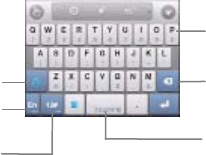
-17-
You can use voice input to type text. This feature uses Google's
speech-recognition service, so you must have a data connection
on a mobile or Wi-Fi network to use it. Text that you enter by
speaking will be underlined. You can continue entering text, keep
it, or delete it. You can speak to enter text in most places where
you can enter text with the onscreen keyboard.
1. Touch a text field, or a location in text you've already entered
in a text field.
2. Touch the Microphone key on the onscreen keyboard.
3. When you see the microphone image, speak what you want
to be typed.
TouchPal
Delete a character
before the cursor.
Switch to
symbol,number,smiey
Insert space
Change between
lowercase and uppercase
Switch among English and
Spanish
Input letter

-18-
Using your phone safely
On the road
Using a phone while driving is illegal in many countries.
Please follow local laws and drive safely at all times.
Near sensitive electronics
Don’t use your phone near sensitive electronic equipment –
particularly medical devices such as pacemakers – as it could
cause them to malfunction. It can also interfere with the
operation of fire detectors and other automatic-control
equipment.
For more information about how your phone affects
pacemakers or other electronic equipment, please contact
the manufacturer or your local distributor.
Your phone may cause interference when used near TVs,
radios or automated office equipment.
While flying
Your phone can cause interference with aircraft equipment. So
it’s essential you follow airline regulations. And if airline
personnel ask you to switch off your phone, or disable its
wireless functions, please do as they say.
In hospital
Your phone may interfere with the normal operation of medical
equipment. Follow all hospital regulations and turn it off when

-19-
you’re asked to by posted warnings or medical staff.
At a petrol station
Don’t use your phone at petrol stations. In fact, it’s always best
to switch off whenever you’re near fuels, chemicals or
explosives.
Around water
Keep your phone away from water (or any other liquid). It’s not
a waterproof model.
Making repairs
Never take your phone apart. Please leave that to the
professionals. Unauthorised repairs could break the terms of
your warranty.
Broken antenna
Don’t use your phone if the antenna is damaged, as it could
cause injury.
Around children
Keep your phone out of children’s reach. It should never be
used as a toy and it might not be good for their health.
Original accessories
Only use the original accessories supplied with your phone or
those approved by the manufacturer. Using unapproved

-20-
accessories may affect performance, make the warranty void,
break national regulations on the use of phones, or even cause
injury.
Near explosives
Turn off your phone in or near areas where explosive materials
are used. Always obey local laws and turn off your phone when
requested.
Emergency calls
To make an emergency call your phone must be turned on
and in an area where there’s network coverage. Dial the
national emergency number and touch ‘send’. Explain exactly
where you are and don’t hang up until help has arrived.
Working temperature
The working temperature for the phone is between 0℃ and
40℃. Please don’t use the phone outside the range. Using the
phone under too high or too low temperature might cause
problems.
At very high volume, prolonged listening to a phone
can damage your hearing.
Battery care and safety
Keep the battery in a cool, ventilated place and out of direct
sunlight.

-21-
Although the battery is rechargeable, it’ll eventually start to lose
its ability to recharge. If you find that the battery won’t recharge,
it’s time to replace it.
Please don’t throw old batteries into your household rubbish.
You’ll find there are special bins for batteries at refuse collection
points. And some high street electrical stores provide a battery
recycling service too.
Never throw the battery into a fire – it’s highly inflammable and
could explode, hurting you or somebody else.
When you put the battery into your phone, there’s no need to
use force. Exerting too much pressure could make it leak,
overheat, explode or burst into flame.
Never take the battery apart. This may result in leakage,
overheating, explosion or fire.
If the battery becomes hot, changes colour or shape at any
time (when in use, charging or even while in storage) please
stop using it immediately and replace.
Keep the battery dry. Damp or wet conditions can cause it to
overheat or corrode.
Don’t leave the battery in direct sunlight or anywhere really hot,
like in a car on a summer’s day. That could make it leak or
overheat, while lowering its performance and shortening its life.
Don’t charge the battery continuously for 24 hours.
Overcharging is not good for it.
Note:

-22-
Please avoid contact with the materials inside a
damaged or leaking battery. If they get on your skin,
wash with lots of water and seek medical assistance if
required.
-23-
Charger care and safety
Only plug into voltages between 100VAC and 240VAC. Using
a voltage outside that range can damage the phone/charger –
and cause the battery to leak or catch fire.
Never short-circuit the charger – this may cause electrocution,
overheating or damage.
Don’t charge the phone in direct sunlight or in an area where it’s
damp, dusty, or on a vibrating surface. And charging your
phone near – or on – a TV or radio could interfere with
transmission.
Don’t use the charger if the power cable is damaged. It may
cause a fire or give someone an electric shock.
Keep water well away from the charger. If the charger does
get splashed by water, or any other kind of liquid, immediately
unplug it to avoid overheating, fire or electrocution.
Don’t take the charger apart. It could cause injury, give you an
electric shock or catch fire.
Never touch any charger, electric cable or socket with wet
hands.
Don’t place heavy objects on the electric cable.
If the cable is damaged, don’t try to mend it yourself – it could
cause a fire or electrocute you.
Always unplug the charger before you clean it.
When unplugging the charger, hold the plug itself, rather than
pulling on the cable. A damaged cable can cause
-24-
electrocution or fire.
-25-
Care and maintenance
Your phone is a delicate device. The following advice will help
you to keep it looking good and performing well…
Use a soft dry cloth to clean your phone, battery and charger.
Don’t use liquids such as alcohol, dilution agents or benzene.
From time-to-time, clean the socket where the charger cable
connects to the phone. Dust tends to gather there. This will
ensure a really good connection.
Don’t use needles, pen points or other sharp objects on the
keypad or screen.
Don’t use your phone with wet hands – it could injure you and
damage the phone.
Don’t use your phone in dusty or dirty environment.
Keep your phone away from extremes of heat – like radiators
or ovens. It may explode if it gets too hot.
If your phone gets wet and the colour of the label on it
changes, the warranty will be void, even if the warranty period
hasn’t expired.
If there’s anything wrong with the phone, battery, charger, or
any accessory, please send them to your nearest service
centre for inspection.
-26-
Health and safety
FCC regulations
This mobile phone complies with part 15 of the FCC Rules.
Operation is subject to the following two conditions: (1) This
device may not cause harmful interference, and (2) this device
must accept any interference received, including interference that
may cause undesired operation.
This mobile phone has been tested and found to comply with the
limits for a Class B digital device, pursuant to Part 15 of the FCC
Rules. These limits are designed to provide reasonable protection
against harmful interference in a residential installation. This
equipment generates, uses and can radiated radio frequency
energy and, if not installed and used in accordance with the
instructions, may cause harmful interference to radio
communications. However, there is no guarantee that interference
will not occur in a particular installation If this equipment does
cause harmful interference to radio or television reception, which
can be determined by turning the equipment off and on, the user is
encouraged to try to correct the interference by one or more of the
following measures:
-Reorient or relocate the receiving antenna.
-Increase the separation between the equipment and receiver.
-Connect the equipment into an outlet on a circuit different from
that to which the receiver is connected.
-Consult the dealer or an experienced radio/TV technician for
help.
-27-
Changes or modifications not expressly approved by the party
responsible for compliance could void the user‘s authority to
operate the equipment.
The antenna(s) used for this transmitter must not be co-located or
operating in conjunction with any other antenna or transmitter.
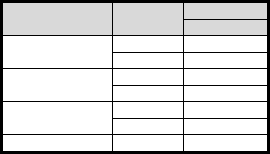
-28-
4RF exposure information (SAR)
This mobile phone meets the government’s requirements for
exposure to radio waves.
This phone is designed and manufactured not to exceed the emission
limits for exposure to radio frequency (RF) energy set by the Federal
Communications Commission of the U.S. Government.
The exposure standard for wireless mobile phones employs a unit of
measurement known as the Specific Absorption Rate, or SAR. The
SAR limit set by the FCC is 1.6W/kg. *Tests for SAR are conducted
using standard operating positions accepted by the FCC with the
phone transmitting at its highest certified power level in all tested
frequency bands. Although the SAR is determined at the highest
certified power level, the actual SAR level of the phone while
operating can be well below the maximum value. This is because the
phone is designed to operate at multiple power levels so as to use
only the poser required to reach the network. In general, the closer
you are to a wireless base station antenna, the lower the power
output.
The highest SAR value for the model phone as reported to the FCC,
described in this user guide, is
Band Position SAR 1g
(W/kg)
GSM850 Head 0.214
Body 0.533
GSM1900 Head 0.370
Body 1.030
WCDMA Band V Head 0.350
Body 0.624
WCDMA Band II Head 0.667
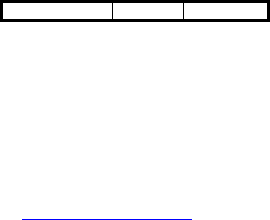
-29-
Body 1.090
(Body-worn measurements differ among phone models, depending
upon available accessories and FCC requirements.)
While there may be differences between the SAR levels of various
phones and at various positions, they all meet the government
requirement.
The FCC has granted an Equipment Authorization for this model
phone with all reported SAR levels evaluated as in compliance with
the FCC RF exposure guidelines. SAR information on this model
phone is on file with the FCC and can be found under the Display
Grant section of http://www.fcc.gov/oet/fccid after searching on FCC
ID: Q78-V8200PLUS.
For body worn operation, this phone has been tested and meets the
FCC RF exposure guidelines for use with an accessory that contains
no metal and the positions the handset a minimum of 1.0 cm from the
body. Use of other accessories may not ensure compliance with FCC
RF exposure guidelines. If you do no t use a body-worn accessory
and are not holding the phone at the ear, position the handset a
minimum of 1.0cm from your body when the phone is switched on.
This device is compliance with SAR for general population
/uncontrolled exposure limits in ANSI/IEEE C95.1-1999 and had been
tested in accordance with the measurement methods and procedures
specified in OET Bulletin 65 Supplement C.
-30-
Declaration of RoHS compliance
We’re determined to reduce the impact we have on the environment
and take responsibility for the earth we live on. So this document
allows us to formally declare that the V8200+, manufactured by ZTE
CORPORATION, fully complies with the European Parliament’s
RoHS (Restriction of Hazardous Substances) Directive 2002/95/EC,
with respect to all the following substances:
(1) Lead (Pb)
(2) Mercury (Hg)
(3) Cadmium (Cd)
(4) Hexavalent Chromium (Cr (VI))
(5) Polybrominated biphenyl (PBB)
(6) Polybrominated diphenyl ether (PBDE)
Our compliance is witnessed by written declaration from our suppliers.
This confirms that any potential trace contamination levels of the
substances listed above are below the maximum level set by EU
2002/95/EC, or are exempt due to their application.
The V8200+ manufactured by ZTE CORPORATION, meets all the
requirements of EU 2002/95/EC.

-31-
Disposal of your old phone
1. When the wheelie bin symbol is attached to a
product, it means the product is covered by the
European Directive 2002/96/CE.
2. All electrical and electronic products should be
disposed of separately from normal household waste
via designated collection points provided by
government or local authorities.
3. The correct disposal of electrical and electronic
products will help protect the environment and
human health.